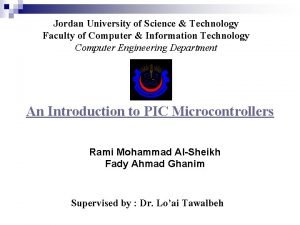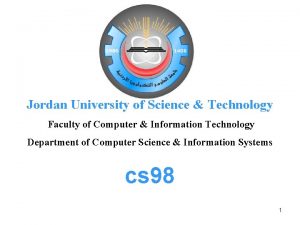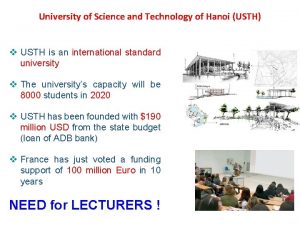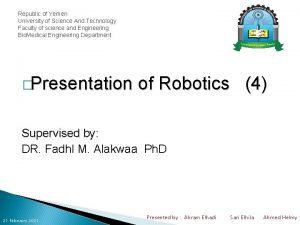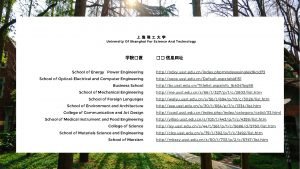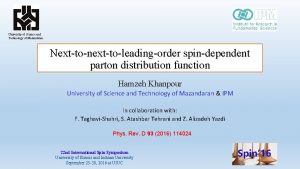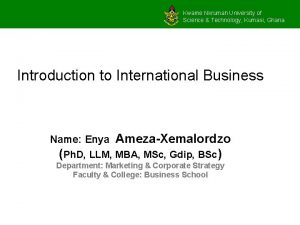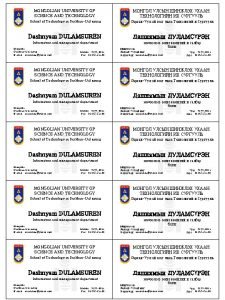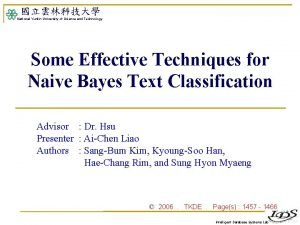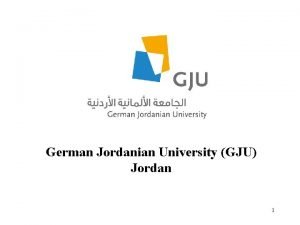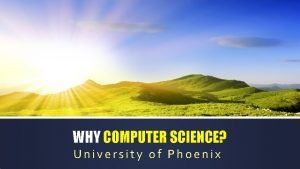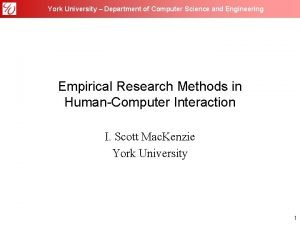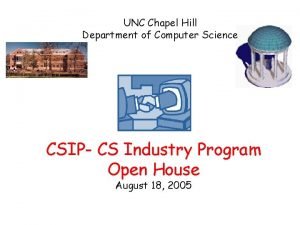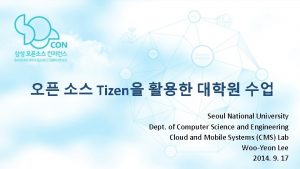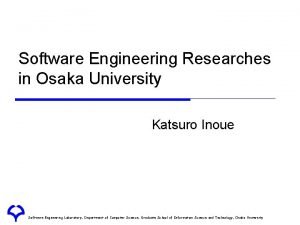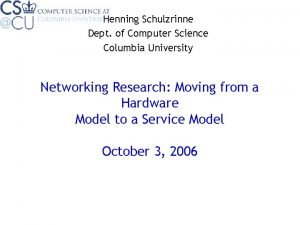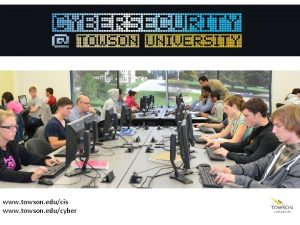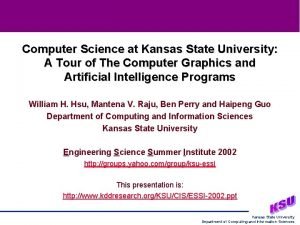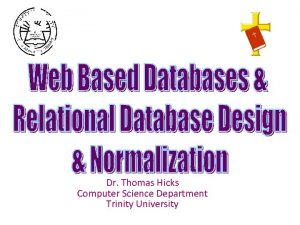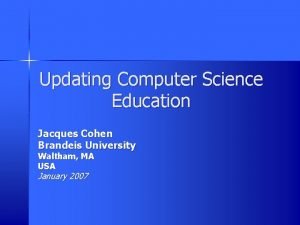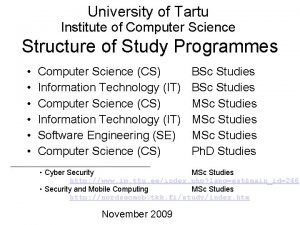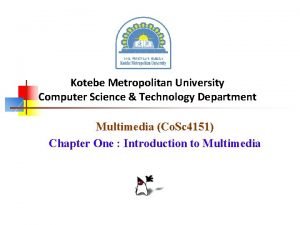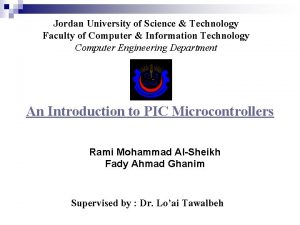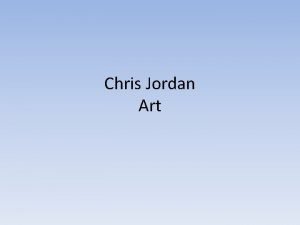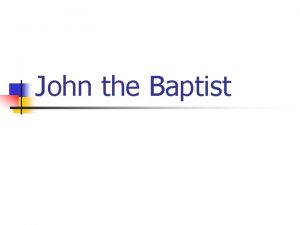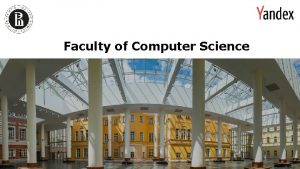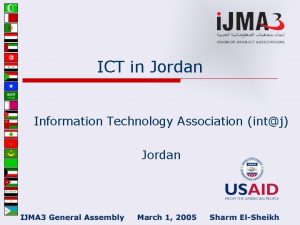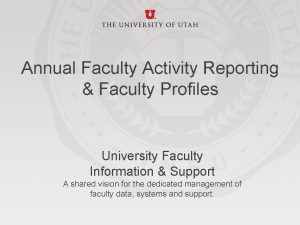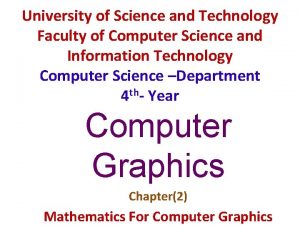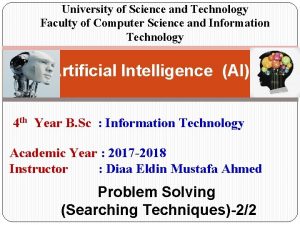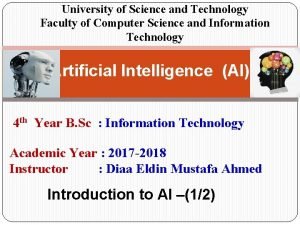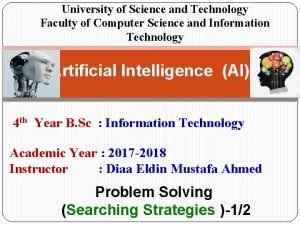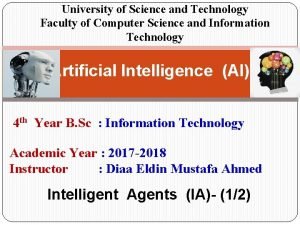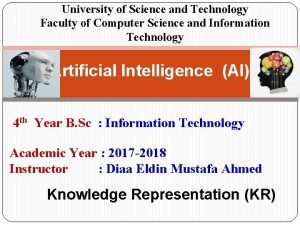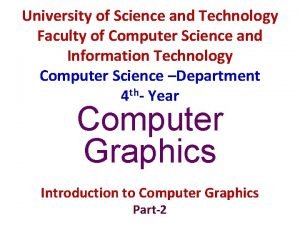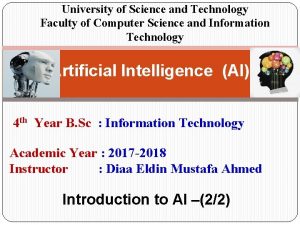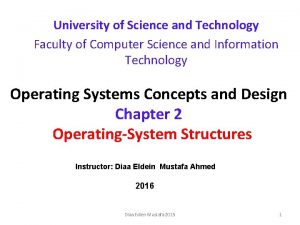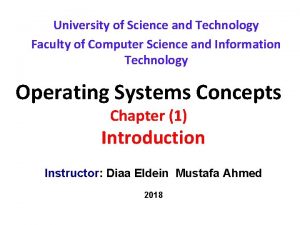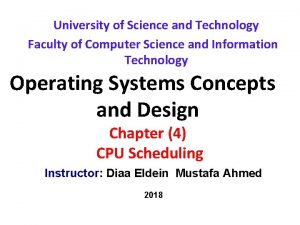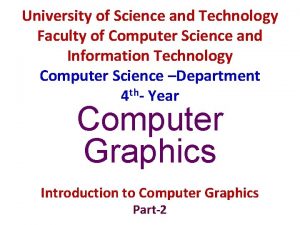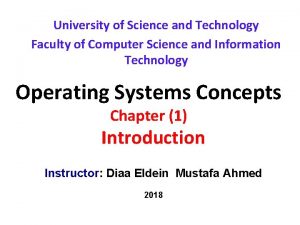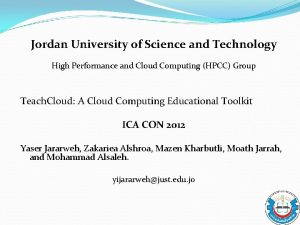Jordan University of Science Technology Faculty of Computer



























































- Slides: 59

Jordan University of Science & Technology Faculty of Computer & Information Technology Department of Computer Science & Information Systems cs 98 1

Chapter 1 Introduction to Computers 2

What are computers? Computers are electronic devices that can follow instructions to accept input, process the input and then produce information. 3

Look inside the computer SOFTWARE HARDWARE 4

Computers are made of 1. HARDWARE 2. SOFTWARE 5


Hardware The parts of computer itself (tangible objects ) including : l CPU (or Processor) and Primary memory (or Main Memory) l Input devices i. e the keyboard and mouse l Output devices l Storage devices 7

The Case (System Unit or System Cabinet) ﻏﻴﺮ ﻣﻄﻠﻮﺑﺔ ﻓﻘﻂ ﻟﻠﻔﻬﻢ 8

Hardware 1. 2. 3. 4. Central Processing Unit (CPU) Input units Output units Memory (Main or Primary Memory & Secondary or Auxiliary Memory) 9

Components of a Computer System Data Central Processing Unit (CPU) control unit (CU) Input units Arithmetic logic Unit (ALU) Memory RAM output units ROM Auxiliary Memory Information 10 /Knowledge

Hardware Organization Input Devices. . . CPU memory motherboard hard drive ﻏﻴﺮ ﻣﻄﻠﻮﺑﺔ ﻓﻘﻂ ﻟﻠﻔﻬﻢ 11

Input Devices • Translate data from form that humans understand to one that the computer can work with • Most common are keyboard and mouse Selector Buttons 12

Examples of Input Devices 1. Keyboard (QWERTY keyboard, ATMs keyboard) ATM: automatic teller machine 2. Mouse 3. Scanner 4. Pre-storage Devise (Disk, CD’s, … etc. ) 5. Optical mark recognition (Light Pin , Bar code scanners) 6. Microphone 7. Joystick. See Page 4 in text book 13

Examples of Input Devices(2) 8. Point and Draw devices 9. Trackball 10. Touchpad 11. Touch screen 12. Magnetic stripes and smart cars. 13. Digital Cameras 14

15

Hardware Organization CPU memory hard drive 16 ﻏﻴﺮ ﻣﻄﻠﻮﺑﺔ ﻓﻘﻂ ﻟﻠﻔﻬﻢ

Hardware Organization CPU memory motherboard ﻏﻴﺮ ﻣﻄﻠﻮﺑﺔ ﻓﻘﻂ ﻟﻠﻔﻬﻢ hard drive 17

Central Processing Unit (CPU) • A specific chip or the processor a CPU's performance is determined by the rest of the computers circuitry and chips. • The Central Processing Unit (CPU) performs the actual processing of data • The speed (clock speed) of CPU measured by Hertz (MHz) 18

The CPU consists of : q Control Unit (CU) q Arithmetic and Logical Unit (ALU) q Some Registers 19

The Control Unit (CU) : coordinates all activities of the computer by: • Determining which operations to perform and in what order to carry them out. • The CU transmits coordinating control signals to other computer components. 20

The ALU : consists of electronic circuitry to perform: • Arithmetic operations (addition, subtraction, multiplication and division) • Logical operations (and, or, not, …) and to make some comparisons (less-than, equal, … etc. ) 21

Hardware Organization CPU memory motherboard hard drive ﻏﻴﺮ ﻣﻄﻠﻮﺑﺔ ﻓﻘﻂ ﻟﻠﻔﻬﻢ 22

Primary Memory • Memory (fast, expensive, short-term memory): Enables a computer to store, at least temporarily, data, programs, and intermediate results. • Two general parts: 1. RAM 2. ROM 23

RAM (Main Memory) • its a primary storage or random access memory (RAM). • it temporarily holds data and programs for use during processing (volatile) • Any information stored in RAM is lost when the computer is turned off. • RAM is the memory that the computer uses to temporarily store the information as it is being processed. The more information being processed the more RAM the computer needs. • RAM consists of locations or cells. Each cell has a unique address which distinguishes it from 24 other cells.

ROM: Read Only Memory ROM is part of memory n Programmed at manufacturing time n Its contents cannot be changed by users n It is a permanent store 25

Secondary Storage q Stores data and programs permanently: its retained after the power is turned off q Examples • Hard Drive (Hard Disk) Located outside the CPU, but most often contained in the system cabinet • Floppy Disk • Optical Laser Discs v. CD-ROM, CD-RW, and DVD 26

Kinds of Disk Drives 27

Common Secondary Media • Diskettes – Data represented as magnetic spots on removable flexible plastic disks – Most common size is 3 1/2 inches, in a rigid plastic case – Disk drive holds the diskette, reads or retrieves the data and writes or stores data 28

Common Secondary Media • Hard drive – Data is represented magnetically as with diskettes – Normally more than one rigid platter in a platter sealed unit – These disks are not removable disks – Significantly more capacity and faster operating than diskettes 29

Hardware Organization CPU memory motherboard hard drive ﻏﻴﺮ ﻣﻄﻠﻮﺑﺔ ﻓﻘﻂ ﻟﻠﻔﻬﻢ 30

Common Secondary Media § Optical Laser Discs • CD ROM & DVD’s • Data is represented as pits and lands • Some kinds are read only (CD-ROM) and some Kinds are rewritable (CD-RW) • Significantly more capacity and faster operating than diskettes 31 DVD: Digital Video Disk

Hardware Organization CPU memory hard drive Output … ﻏﻴﺮ ﻣﻄﻠﻮﺑﺔ ﻓﻘﻂ ﻟﻠﻔﻬﻢ 32

CPU Output Devices P in roc fo rm ess at ed io n Pieces of equipment that translate the processed information from the CPU into a from into form that humans can understand. 33

Output Devices § Monitors § Printers Ø Dot matrix printers Ø Ink jet printers Ø Laser printers § Sound Blasters (Sound Card By Creative Lab) § Controlling other devices 34

Software The instructions that tell the computer what to do 1. Application Software - helps end-users perform general purpose tasks 2. System Software - enables application software to interact with the computer 35

System Software The most important System Software is the Operating System Examples of operating systems: Windows XP, DOS, Apple, UNIX 36

System Software • The software that controls everything that happens in a computer. • Background software, manages the computer’s internal resources Resources examples : CPU, RAM , I/O devices, … 37

Application Software – Basic Tools • Word processors– example: Microsoft word • Spreadsheets-- example: Microsoft Excel • Database managers-- example: Microsoft Access • Graphics-- example: Photoshop Spreadsheets: Computer software that allows the user to enter columns and rows of numbers in a accounting book like format. 38

Units of Measurements § Bit (Binary Digit)(takes two values: 1 or 0) § Byte = 8 bits § § KB (Kilo-byte) = 1024 bytes MB (mega-byte) = 1024 KB GB (giga-byte) = 1024 MB TB (Tera-byte) = 1024 GB Remark: 1024=210 39

Four Kinds of Computers 1. Microcomputers 2. Minicomputers 3. Mainframe computers 4. Supercomputers 40

• Microcomputer =>Personal Computer => PC • There are 3 types of the Microcomputers : 1. Laptop 2. Desktop 3. Workstation 41

• Personal Computer : A small, single-user computer based on a microprocessor. • Workstation: A powerful, single-user computer. A workstation is like a personal computer, but it has : Ø a more powerful microprocessor and, Ø in general, a higher-quality monitor. 42

Minicomputer, Mainframe, and Supercomputer • Minicomputer: A multi-user computer capable of supporting up to hundreds of users hundreds simultaneously • Mainframe: A powerful multi-user computer capable of supporting many hundreds or or thousands of users simultaneously. thousands simultaneously • Supercomputer: An extremely fast computer that can perform hundreds of millions of instructions per second. 43

Minicomputers • Desk-sized • More processing speed and storage capacity than microcomputers • General data processing needs at small companies • Larger companies use them for specific purposes 44

Mainframe Computers • Larger machines with special wiring and environmental controls • Faster processing and greater storage than minicomputers • Typical machine in large organizations 45

Supercomputers • The most powerful of the four categories • Used by very large organizations, particularly for very math-intensive types of tasks 46

Supercomputers 47

Characteristics of Computers 1 - Store a large amount of data and information for a long period of time. 2 - process data and information in high accuracy level. 3 - Speed in processing data information. 4 - Sharing of information / network. 48

Understanding the difference between Data, Understanding Information and Knowledge: Data Computer Information Knowledge 49

ü Data: Data is the name given to basic facts such as names and numbers. ü Information: Information is data that has been converted into a more useful or intelligible form. ü Knowledge: Knowledge arrangement of information and classifying information of the same type or the same topic. 50

• e. g. -2 4 0 -3 10 (data) data | | sort / -3 -2 0 4 10 (information) information 51

Processing data produces information, and processing information produces knowledge. 52

Computer Viruses 53

Computer Viruses • A computer virus is an application program designed and written to destroy other programs. • It has the ability to: Ø Link itself to other programs Ø Copy itself (it looks as if it repeats itself) 54

Examples of Viruses n Monkes n ABC n Crabs n CIH 55

Viruses and Virus Protection • A virus program • Infects programs, documents, databases and more … • It is man-made • It can hide and reproduce • It can lay dormant (inactive) and then activate Anti-virus programs can h 56

Sources of Computer Viruses • Three primary sources • The Internet • Via downloads and exchanges • Diskettes • Exchanging disks • Computer networks • Can spread from one network to another 57

How do you know if you have a virus? • • Lack of storage capability Decrease in the speed of executing programs Unexpected error messages Halting the system 58

Virus Protection • The software package distributed with new PCs always includes an antiviral program. The best way to cope with viruses is to recognize their existence and use an antiviral, or antivirus program. 59
 Jordan university of science and technology
Jordan university of science and technology Jordan university of science and technology ranking
Jordan university of science and technology ranking Jordan university of science and technology
Jordan university of science and technology University of bridgeport computer science faculty
University of bridgeport computer science faculty Computer science tutor bridgeport
Computer science tutor bridgeport Fsu computer science
Fsu computer science Brown university computer science faculty
Brown university computer science faculty Personal tutor ucl
Personal tutor ucl Hanoi university of science and technology vietnam
Hanoi university of science and technology vietnam Ulsan national institute of science and technology
Ulsan national institute of science and technology Science technology university yemen
Science technology university yemen University of shanghai for science and technology
University of shanghai for science and technology University of science and technology of mazandaran
University of science and technology of mazandaran Pingtung university of science and technology
Pingtung university of science and technology University of science and technology kumasi
University of science and technology kumasi Mongolian university of science and technology logo
Mongolian university of science and technology logo National yunlin university of science and technology
National yunlin university of science and technology Think central k5
Think central k5 Hijjawi faculty for engineering technology
Hijjawi faculty for engineering technology German university jordan
German university jordan My favourite subject is english because
My favourite subject is english because Phoenix online computer science university
Phoenix online computer science university Yonsei university computer science
Yonsei university computer science York university computer science
York university computer science Unc chapel hill computer science
Unc chapel hill computer science Seoul national university computer science
Seoul national university computer science Osaka university computer science
Osaka university computer science Computer science columbia university
Computer science columbia university 7800 york road
7800 york road Kstate computer science
Kstate computer science Trinity university computer science
Trinity university computer science Brandeis computer science
Brandeis computer science University of tartu institute of computer science
University of tartu institute of computer science Kotebe metropolitan university fields
Kotebe metropolitan university fields Webnis
Webnis Herszon kherson maritime college of merchant marine fleet
Herszon kherson maritime college of merchant marine fleet Hubert kairuki memorial university faculty of medicine
Hubert kairuki memorial university faculty of medicine Semmelweis university faculty of medicine
Semmelweis university faculty of medicine King abdulaziz university faculty of medicine
King abdulaziz university faculty of medicine Mendel university faculty of business and economics
Mendel university faculty of business and economics Singularity executive program
Singularity executive program Territorial matrix vs interterritorial matrix
Territorial matrix vs interterritorial matrix Ascaris lumbricoides ova
Ascaris lumbricoides ova Feup university of porto
Feup university of porto Webkredit cuni
Webkredit cuni Faculty of veterinary medicine cairo university logo
Faculty of veterinary medicine cairo university logo Faculty of law of the university of zagreb
Faculty of law of the university of zagreb University of montenegro faculty of law
University of montenegro faculty of law University of kragujevac faculty of technical sciences
University of kragujevac faculty of technical sciences University of cologne faculty of management
University of cologne faculty of management Leading university founder
Leading university founder Hacettepe university faculty of medicine
Hacettepe university faculty of medicine دانشگاه دامپزشکی تهران
دانشگاه دامپزشکی تهران Semmelweis university faculty of medicine
Semmelweis university faculty of medicine Ulfg2
Ulfg2 York u myfile
York u myfile Elearningunideb
Elearningunideb Ece clemson
Ece clemson Faculty of veterinary medicine cairo university
Faculty of veterinary medicine cairo university Faculty of mechanical engineering thammasat university
Faculty of mechanical engineering thammasat university
